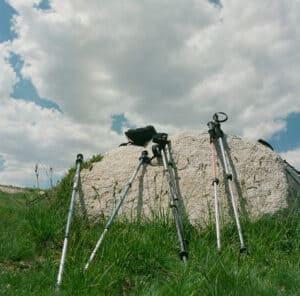Do hiking sticks really help? Ever wondered if hiking sticks are just a fancy accessory or if they really do offer some tangible benefits? I’ve been down that road too. In this article, I’ll delve into the nitty-gritty of hiking sticks, shedding light on their usefulness (or lack thereof). Do hiking sticks really help?
Benefits of Hiking Sticks

As an avid hiker, I’ve seen a lot of skepticism around the topic of hiking sticks. Are they truly beneficial, or are they just a hiking fashion statement? Through experience and research, I’ve found that hiking sticks offer several tangible benefits.
Firstly, let’s look at balance. Hiking sticks enhance stability, especially over rocky, uneven terrains. They’re like an extra set of hands supporting you – making slips, trips and falls less likely. Uneven ground’s a routine part of life for hikers – so this added balance can be something of a game-changer.
Next up, we have effort distribution. Hiking sticks provide another point of contact with the ground, which helps distribute the physical effort across different parts of the body. Think about it – your arms and shoulders share the load bearing task usually managed by the legs alone. This distribution lessens fatigue, allowing you to go champion distances – and who doesn’t want that!
Energy conservation is third on the list. A study by Northumbria University found that using hiking sticks can save up to 20% of your energy during a hike. That’s a noticeable amount, particularly on those long, grueling treks. More energy equals more endurance.
Let’s consider joint protection. Hiking’s an activity of repetitive movements which can be tough on the joints – just ask a seasoned hiker’s knees! Hiking sticks also offer an element of protection against this. They reduce the strain and impact on your knees, especially during downhill sections of your route.
Finally: the underestimated perk of a hiking stick as a multi-purpose tool. Need to check water depth? Hiking stick. Brushing away spider webs? Hiking stick. Deter a curious animal? Well, you’ve got it – hiking stick.
I’ve touched on just a few key benefits here. There are several more to consider. Before writing off hiking sticks as an accessory, incorporate them into your hikes. You might just feel the benefits yourself.
Improve Balance and Stability
You might be wondering, do hiking sticks really offer balance? Well, the answer is a resounding yes. I’ve found that hiking sticks greatly improve stability and balance, even on uneven terrains. Think about your hiking experience as walking on a tightrope. If you’ve noticed circus artists walking on tightropes, you’ll remember they always carry a long rod. It’s not just for show – it helps distribute their body weight evenly and maintains balance.
The same principle applies to hiking with sticks. They’ll serve as your extra pair of feet, reducing the chances of slips, trips, and falls.
- Extra Points of Contact: With hiking sticks, you get two additional points of contact with the ground. This forms a more stable, four-point walking technique, distributing your weight more evenly. In a way, hiking with sticks can offer you the steadiness of a mountain goat traipsing across unpredictable terrains.
- Streamline Movements: Deploying hiking sticks enables smoother, more rhythmic movements. When you’re navigating tricky descents or rocky climbs, hiking sticks can help streamline your motions, keeping you balanced and undeterred.
Backpacking also means heavy loads strapped to your back. Such a load significantly shifts your center of gravity, making you prone to sudden falls. Here, too, hiking sticks can help maintain your balance, providing stable support and offsetting the weight of the pack.
Remember, though, that using hiking sticks is an acquired skill. For it to be truly effective, you must learn the right technique to use them. It might seem awkward in the beginning, but with a little practice, you’ll be navigating terrains like a pro, with enhanced stability and balance.
Reduce Impact on Joints

Beyond just enhancing balance and stability, let’s delve deeper into another crucial advantage of hiking sticks. They’re a godsend for reducing the impact on your joints. Let’s understand how.
When I’m on the trail, I’ve often felt the impact on my knees, especially during descents. And I’m not alone. Many other hikers shared the same woes. Enter hiking sticks. The slightly leaning posture you adopt when using them takes a significant amount of weight off your legs. Therefore, trail impact on your knees and hips reduces significantly. It’s a relief that long-distance hikers and those with joint problems would genuinely appreciate.
Ever stocked your backpack up to its brim? I have, multiple times. But the excess load means the added downward pressure on our leg joints. It feels like carrying dumbbells on a treadmill. Thankfully, the correct use of hiking sticks can redistribute this weight, easing the strain on your knees and hips.
Here’s how it works:
- You transfer part of your body weight onto the hiking sticks through your arms.
- This reduces the cumulative weight your lower body joints (ankles, knees, and hips) have to bear.
- Hence, when you move, these joints experience less wear and tear.
This is not a hasty presumption. This fact is backed by science. A study by the Journal of Sports Science indicates a 25%-40% drop in kinetic forces acting on knees when using hiking sticks during a hike.
In short, not only do hiking sticks help you navigate different trail conditions nimbly, but they also lower the overall toll on your joints. They’re true backcountry essentials, especially if you’re a frequent hiker, or have joint concerns.
Now let’s keep our walking sticks firm on the trail and focus on the next benefit. Aren’t you curious about what’s coming up next?
Increase Endurance and Efficiency
Adding on to their myriad benefits, hiking sticks also play a remarkable role in boosting overall hiking efficiency.
When on a long and demanding trail, energy conservation becomes critical. Surprisingly, the appropriate use of hiking sticks can lead to increased stamina. While it might appear counterintuitive to carry something, I’ve found that this little shift can often be the difference between an invigorating hike and a taxing one.
Why does it work this way? Why would an “added weight” increase rather than decrease efficiency? The answer lies in workload distribution. By employing hiking sticks, you’re effectively redistributing the workload across four limbs instead of two. It’s a simple concept, yet it’s transformative in practice.
Consider the grueling trails that require frequent and steep ascending. Unaided, you’d be exclusively leveraging your leg muscles, placing significant stress on them over time. But when using hiking sticks, these workhorse muscles of yours get some help. You can harness your upper body strength – utilizing your shoulder, back, and arm muscles – to aid in propelling yourself upward. Ultimately, this leaves you less worn out, with a reserve of energy for the longer haul, there are studies that evoke a 20% decrease in energy expenditure when using hiking sticks during uphill walking.
While they supercharge stamina, hiking sticks also heighten efficiency. You’re able to move quicker with lesser efforts, primarily due to the enhanced balance and stability they offer. This added efficiency is invaluable not just over challenging terrains, but also while navigating flats or descending slopes, essentially covering all aspects of a typical hiking trail.
The takeaway? Hiking sticks, far from being mere supportive gear, offer a tangible impact on your endurance and efficiency when hiking. Less strain on your joints, better balance, and now, amplified stamina and efficiency – they’re making a compelling case for themselves, wouldn’t you say?
Proper Technique for Using Hiking Sticks

Knowing how to effectively use hiking sticks is key to reaping their full benefits. When used correctly, they’ll help maintain balance, reduce joint impact, and even boost endurance. So, let’s dive into the proper techniques you should adopt.
Adjusting the Hiking Sticks
First, you’ve to adjust the hiking sticks according to your height. This isn’t rocket science. Just plant the stick next to you and ensure its handle reaches your waistline. If it doesn’t, adjust the length until it does. The key here is to keep your arm at a 90-degree angle when the stick is on the ground beside your foot. This posture helps maximize balance and stability.
Grip and Wrist Straps
Hold your hiking stick using a relaxed grip. This means your hand should be comfortable, not super tight. Utilize the wrist strap as well. By doing so, you’re redistributing pressure away from your hand and engaging your arm instead. This way, you’ll less likely to get fatigue or blisters.
Walking with Hiking Sticks
While navigating flat terrains, place your hiking stick a step ahead of you, mirroring the opposite leg. It’s a similar motion to a natural walking rhythm. But with uphill or downhill terrains? The method changes slightly.
For uphill climbs, shorten the stick’s length. Place it in front of you to stabilize your steps and push your body upwards. It’s like using them as mini stick cranes pulling you up. The opposite goes for descents: lengthen the sticks and place them in front of you. This way, they can absorb most of the impact and save your knees from unnecessary strain.
Whether it’s uphill, downhill, or flat terrains, the correct use of hiking sticks will significantly increase the benefits you derive from them and make your hiking experience more enjoyable overall.
Conclusion: Do Hiking Sticks Really Help?
After diving deep into the world of hiking sticks, it’s clear they’re not just a hiker’s accessory, but a vital tool. They enhance stability, improve balance, and lessen the impact on your joints. But remember, it’s not just about having them, it’s about using them correctly. Adjust the height, grip lightly, and make use of those wrist straps. Whether you’re traversing flat lands, climbing uphill, or descending, hiking sticks are there to assist. So, do hiking sticks really help? I’d say, without a doubt, they do. They not only make your hikes more enjoyable but also contribute to a safer hiking experience. So next time you hit the trails, don’t forget your trusty hiking sticks!

